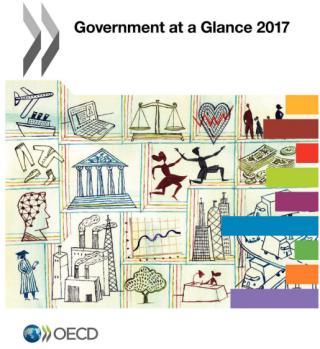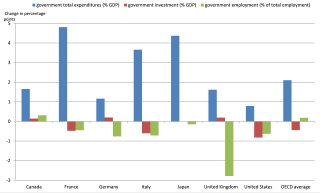Posted by Santiago González[1]
Since 2009, the OECD has produced a biennial Government at a Glance (G@G) publication which contains a set of public governance indicators covering OECD members and partner countries. The fifth edition of G@G, released in July 2017, provides the latest available evidence on governments’ performance from an international comparative perspective. It includes two new chapters dedicated to public sector innovation and governance risk and features several new composite indicators in recurrent areas such as regulatory governance, human resources management, open government data and performance budgeting.
Some of the key findings and stylized facts from this publication on trends in government spending (see Figure 1) and the management of public finances are discussed below:
- Over the period 2007-2015, ageing populations and high unemployment, drove up social costs from an OECD average of 37% of overall spending in 2007 to an average of 41% in 2015. Nevertheless, government’s cost cutting measures and efficiency initiatives trimmed government’s running costs from an OECD average of 39% in 2007 to 37% in 2015.
- Healthcare and social protection are the main drivers behind the increases in spending. Between 2007 and 2015, OECD governments devoted a larger proportion of overall expenditures to social protection and health care. Social protection increased on average by 2.6 percentage points (p.p.) of overall government expenditures, and healthcare increased on average by 1.7 p.p. during the same period.
- Despite low interest rates, public investment has declined on average for OECD countries from a 2009 peak of 9.3% of overall spending to 7.7% in 2015. In 2015, 34% of government investment was allocated to economic affairs, mostly to transportation, followed by defense (15.2%) education (14.7%), general public services (9.3%) and health (8.4%)
Figure 1: Change in Governments Total Expenditures, Investment and Employment, 2007-2015
(Click on the image for a better resolution)
Source: Government at a Glance 2017
- The use of performance budgeting frameworks is widespread with almost three quarters of OECD countries having a framework. Over two-thirds of countries with frameworks, reported using performance information in budget negotiations. Compared with the survey results from 2007 and 2011, more countries reported that poor performance had consequences for the relevant spending ministry/agency/unit. The most common approach is publicizing poor performance, direct budgetary consequences were less frequent, when they did occur, the focus was more on freezing than decreasing the budget.
- The budget process is increasingly used as a tool to advance gender equality. By 2016, fifteen OECD countries had introduced gender budgeting or were actively considering doing so. Most of those countries that have not formally introduced gender budgeting, still include some form of gender-responsiveness in their policy-making processes.
- Since the crisis a higher share of OECD countries are conducting spending reviews. In 2016, 23 OECD countries used spending reviews compared with 16 in 2011. Ten countries (Canada, Greece, Ireland, Italy, Latvia, Luxembourg, Sweden, Switzerland, Mexico and the UK) reported that spending reviews helped them meet 90 percent or more of their fiscal objectives, however nine other countries could not assess the impact of their spending reviews.
- In terms of the effective governance of infrastructure, many OECD countries lack long term strategies, systematic prioritization of projects and clear decision-making mechanisms. Only about a half of OECD member countries have a long term strategic infrastructure vision that cuts across all sectors. Just over half of OECD countries identify a concise list of priority infrastructure projects which takes account of existing infrastructure needs and budget constraints. Political motivation often drives infrastructure investment decisions, and only half of OECD countries have a systematic process for ensuring value for money from infrastructure projects.
Overall, improving public sector performance in OECD countries requires robust and actionable evidence. As Government at a Glance evolves, more and more of its indicators are grounded in recommendations and principles of good practice that OECD member countries subscribe to, thereby providing a commonly agreed normative element for their construction and analysis. For more information, please find the publication available here.
[1] Santiago González is a policy analyst at the OECD Public Governance Directorate.
Note: The posts on the IMF PFM Blog should not be reported as representing the views of the IMF. The views expressed are those of the authors and do not necessarily represent those of the IMF or IMF policy.









